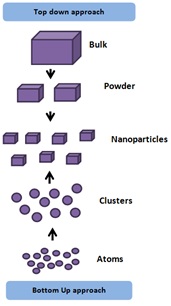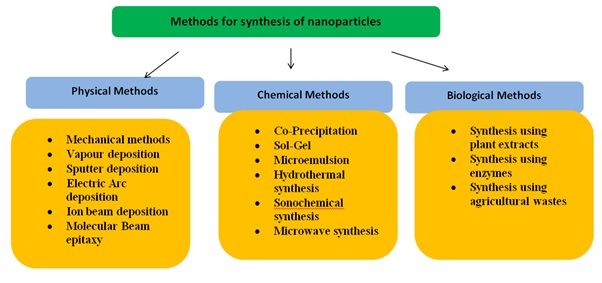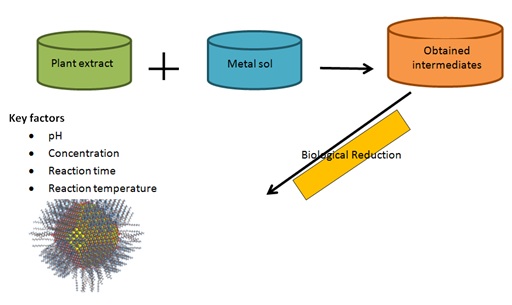
Biosynthesis of Nanoparticles - A New Horizon in Fish Biomedicine
*Corresponding Author(s):
Pani Prasad KurchetiDepartment Of Aquatic Environment And Health Management, ICAR-Central Institute Of Fisheries Education, Mumbai, India
Tel:+91 9867241101,
Email:kpaniprasad@cife.edu.in
Abstract
The biogenic nanoparticle has becoming a significant potential technology as the result of phytomining which revealed that metals are usually deposited in the form of nanoparticles. The various biological agents in the form of algae, plants and microbes have emerged as an efficient candidate for the synthesis of nanoparticles. These biogenic nanoparticles involve producing biomolecules from plant extracts to reduce metal ions to nanoparticlesand it is cost efficient, simpler to synthesize. As this process use water soluble plant metabolites for nanoparticle production, this serves a perfect environmental friendly method which is an added advantage. This greener approach in nanoparticle production against fish pathogens can become an asset for the future aquaculture industry as it serves as a potential alternative to antibiotics which leads a sustained infection - free environment which is the impossible dream for many aquaculturists.
INTRODUCTION
Nanoscience will leave no field untouched by its ground breaking technical innovations but so far the use of nanoscience in fisheries has been predominantly theoretical. Nanoparticles are clusters of atoms in the size of 1-100nm. Due to large surface area to volume ratio these metallic NPs are known to possess remarkable antimicrobial properties by inducing the production of reactive oxygen species such as hydrogen peroxide. Nowadays, a wide variety of nanotechnological applications were arising for the infectious disease treatment which involves micro emulsions, vaccines and metallic, inorganic, lipid and polymeric - based nanoparticles. There were two important metal nanoparticles which were gold and silver nanoparticles [1]. The conclusion of various researches has been shown that among those different NPs; silver NPs shows strong inhibitory and microbicidal activity whereas it exhibits lower toxicity tomammalian cells. It was observed that, there has been emerging advancement in researches on nanoparticles which has lot of scope such as production of burn dressings, scaffolds, water purification systems, antimicrobial applications and medical devices. As this chemical method of nanoparticles production has been becoming the raising concernamong the environmentalists due to their adverse effect on ecology, the use of plant extracts for nanoparticles production is being recommended due its healthy nature towards the environment. Even in the industry it produces much lesstoxic waste. So this bio- nanotechnology, combines biological principles with physical and chemical approaches to produce nano-sized particles with specific functions. Various plant metabolites such as terpenoids, polyphenols, sugars, alkaloids, phenolic acids, and proteins, play an important role in the bio reduction of the metal ions. This article mainly focuses on this emerging green synthesis of nanoparticles with respect to fish medicine applications [2,3].
DIFFERENT APPROACHES TO NANOFABRICATION
For nanofabrication, there followed two common procedures which were top - down and bottom - up approach. Assembling individual atoms and molecules to form nanoparticle describes bottom up approach and top-down approach involves fragmenting material to yield a nanoparticle described below in the figure 1.
 Figure 1: Approaches to Nanofabrication
Figure 1: Approaches to Nanofabrication
SYNTHESIS METHODS
There were 3 common methods for synthesizing nanoparticles which were described below in the figure 2.
 Figure 2: Methods for synthesizing nanoparticles.
Figure 2: Methods for synthesizing nanoparticles.
Among the above described methods, the physical method of synthesizing is time and energy consuming and this involves synthesis at high temperature and pressure. The chemical method is simple and inexpensive and lowtemperature synthesis method, use of toxic reducing and stabilizing agents makes it harmful. The most important green synthesis of nanoparticles were easy, efficient and eco-friendly and this method eliminates the use of toxic chemicals, consume lessenergy and produce safer products and by products. The NPs synthesized in plant extracts already have a functionalized surface that can contain the organic ligands, proteins, polysaccharides and polyatomic alcohols that are absent in NPs synthesized using physical and chemical methods and this proves as a new platform in developing efficient nanoparticles which is recommended more.
GREEN SYNTHESIS
The formation of nanoparticles usingplant extracts has become a major head start method in terms of its interaction and effect on theenvironment; it is completely environmentally friendly and does not pose any threats even from itswaste. During the process production of metal nanoparticles, the plant extract is simply mixed with a solution of metal salt at room temperature (Figure 3). It is a quick reaction and usually takes only minutes to complete. The developed nanoparticle properties and production time depend on various characteristics of plant extract, namely:Its concentration,
- • The concentration of the metal salt,
- • The pH,
- • Temperature; and
- • Contact time

Figure 3: Nanoparticle properties and production time depend on various characteristics of plant extract.
Various plant extracts were used for this green nanoparticle synthesize which are, aloe vera, neem, tea leaves, lemongrass, coriander, cinnamon, gooseberry, ginger, eucalyptus, hydrilla, sea weeds, mangrove plant extracts, hibiscus, latex, mint, tulsi, banana, lotus etc…
ANTIBACTERIAL ACTIVITY AGAINST FISH PATHOGENS
The mechanism of nanoparticles on bacteria are not fully elucidated, the three most common mechanism of toxicity proposed up to now be as follows.
- • Uptake of free silver ions followed by disruption
- • Formation of reactive oxygen species
- • Direct damage to cell membranes
The applications of nanoparticles in aquaculture has promisingly seen in water quality improvement, aquatic animal nutrition, drug delivery, disease diagnosis and management but very few works has been done in the greener approach as it is forming a new horizon in the aquaculture era. Moreover, several reports are availablewhich have shown that AgNPs are effective against pathogenic organism namely B.subtilis, Vibrio cholerae, E.coli and reported that Ag NPs with larger surface area provide a better contact with microorganisms. Biogenic Ag-NP using tea leaf extract (Camellia sinensis) showed bactericidal activity against Vibrio harveyi in juvenile Feneropenaeus indicus, but only at high doses of the nanoparticles.The nanoparticles with leaves of Mangiferaindica (mango), Eucalytusterticonis, Carica Papaya and Musa paradisiacal (banana) plants has developed and tested against Aeromonahydrophila. Among them, synthetized nanoparticles with Carica papaya (papaya) show antimicrobial activity with 153.6 µg mL-1 concentration. In 2015, research on biogenic CuO NPs shows enhanced antibacterial activity against all the fish pathogens even at lower concentrations, i.e. above 20 mu g/mL, which was tested against Aeromonas hydrophila, Pseudomonas fluorescens and Flavobacterium branchiophilum. Further research in 2016 [4], the AgNPs application, using as reductor agent Azadirachta indica were used to evaluate the immune modular effect in infected mirgal with Aeromona hydrophila. Further works on antimicrobial activity of Leucas aspera-engineered silver nanoparticles against A. hydrophilainfections were done in catla. In-vivo analysis of biochemical parameters and histological architecture provided evidence for the antibacterial effect of silver nanoparticles in catla. Moreover, broth of Aloe leaf extract was used for green synthesis of Zinc Oxide Nanoparticles (ZnO-NPs), which showed higher bactericidal activity against A.hydrophilla. Leaf bud extractfrom mangrove Rhizophora mucronata for biological synthesis of Ag-NPs, then demonstrated antimicrobial effects against Pseudomonas fluorescens, Proteus species and Flavobacterium species. The brief discussion on the recent researches on the green nanoparticle applications in fish antibacterial activity described aboveis given in the table below [5]. This green approach in the fish medication of nanoparticles is shown to be a perfect therapy in future if researches have taken seriously in aquaculture industry.
|
AgNPs characteristics |
Microorganisms |
Authors |
|
Synthetized nanoparticles with leaves of Mangifera indica, Eucalytus terticonis, Carica Papaya and Musa paradisiaca plants |
Aeromona hydrophila |
Mahanty, et al. [6] |
|
Green synthesized CuO |
Aeromonas hydrophila, Pseudomonas fluorescens and Flavobacterium branchiophilum |
Swain, et al. [7] |
|
AgNPs using Azadirachta indica |
Aeromona hydrophila |
Rather, et al. [8] |
|
Leucas aspera-engineered AgNPs |
Aeromona hydrophila |
Antony, et al. [9] |
|
AgNP using leaf bud extract from mangrove Rhizophora mucronata |
Pseudomonas fluorescens, Proteus species and Flavobacterium sp |
Umashankari, et al. [10] |
|
AgNP using tea leaf extract |
Vibrio harveyi |
Vaseeharan, et al. [11] |
|
ZnO-NPs using Aloe leaf extract |
Aeromona hydrophila |
Gunalan, et al. [12] |
Table 1: Green nanoparticle application against fish pathogens [13,14].
CONCLUSION
Current research in biosynthesis of nanometals using plant extracts has opened a new era in fast and nontoxic methods for production of nanoparticles. Different methods (physical, chemical and biological) have beendeveloped to obtain NPs of various shapes and sizes. Among that this biological method of NPs is economically and environmentallyfriendly alternative to chemical and physical approaches. But the exact mechanism of synthesis of biogenic nanoparticles needs to be worked out.Based upon the above discussions it can be said that the synthesis of green nanoparticles may serve as a future direction in fish biomedical nanotechnology in developing antimicrobial compounds that are still to be explored.
ACKNOWLEDGEMENT
The authors thank the Director, ICAR-CIFE for providing help in writing this review.
REFERENCES
- Sondi I, Salopek-Sondi B (2004) Silver nanoparticles as antimicrobial agent: A case study on coli as a model for Gram-negative bacteria. Journal of Colloid and Interface Science 275: 177-182.
- Prakash P, Gnanaprakasam P, Emmanuel R, Arokiyaraj S, Saravanan M (2013) Green synthesis of silver nanoparticles from leaf extract of Mimusops elengi, Linn. for enhanced antibacterial activity against multi drug resistant clinical isolates. Colloids and Surfaces B: Biointerfaces 108: 255-259.
- Saxena A, Tripathi RM, Zafar F, Singh P (2012) Green synthesis of silver nanoparticles using aqueous solution of Ficus benghalensis leaf extract and characterization of their antibacterial activity. Materials letters 67: 91-94.
- Ahmed S, Saifullah, Ahmad M, Swami BL, Ikram S (2016) Green synthesis of silver nanoparticles using Azadirachta indica aqueous leaf extract. Journal of radiation research and applied sciences 9: 1-7.
- Singh K, Panghal M, Kadyan S, Chaudhary U, Yadav JP (2014) Antibacterial activity of synthesized silver nanoparticles from Tinospora cordifolia against multi drug resistant strains of Pseudomonas aeruginosa isolated from burn patients. Journal of Nanomedicine & Nanotechnology 5: 1-6.
- Mahanty A, Mishra S, Bosu R, Maurya UK, Netam SP, et al. (2013) Phytoextracts-synthesized silver nanoparticles inhibit bacterial fish pathogen Aeromonas hydrophila. Indian journal of microbiology 53: 438-446.
- Swain P, Nayak SK, Sasmal A, Behera T, Barik SK, et al. (2014) Antimicrobial activity of metal based nanoparticles against microbes associated with diseases in aquaculture. World Journal of Microbiology and Biotechnology 30: 2491-2502.
- Rather MA, Sharma R, Aklakur M, Ahmad S, Kumar N, et al. (2011) Nanotechnology: A novel tool for aquaculture and fisheries development. A prospective mini-review. Fisheries and Aquaculture Journal 16: 1-5.
- Antony JJ, Nivedheetha M, Siva D, Pradeepha G, Kokilavani P, et al. (2013) Antimicrobial activity of Leucas aspera engineered silver nanoparticles against Aeromonas hydrophila in infected Catla catla. Colloids Surf B: Biointerfaces 109: 20-24.
- Umashankari J, Inbakandan D, Ajithkumar TT, Balasubramanian T (2012) Mangrove plant, Rhizophora mucronata (Lamk, 1804) mediated one pot green synthesis of silver nanoparticles and its antibacterial activity against aquatic pathogens. AquatBiosyst 8: 11.
- Vaseeharan B, Ramasamy P, Chen JC (2010) Antibacterial activity of silver nanoparticles (AgNps) synthesized by tea leaf extracts against pathogenic Vibrio harveyi and its protective efficacy on juvenile Feneropenaeus indicus. Lett ApplMicrobiol 50: 352-356.
- Gunalan S, Sivaraj R, Rajendran V (2012) Green synthesized ZnO nanoparticles against bacterial and fungal pathogens. Prog Nat Sci Mater Int 22: 693-700.
- Song JY, Kim (2009) Rapid biological synthesis of silver nanoparticles using plant leaf extracts. Bioprocess and biosystems engineering32:
- Bandeira G, Sutili FJ, Gressler LT, Ely VL, Silveira BP, et al. (2018) Antibacterial potential of phytochemicals alone or in combination with antimicrobials against fish pathogenic bacteria. Journal of applied microbiology125: 655-665.
Citation: Kurcheti PP, Dhayanath, Mary AJ, Jeena, Alim H (2020) Biosynthesis of Nanoparticles - A New Horizon in Fish Biomedicine. J Aquac Fisheries 4: 035.
Copyright: © 2020 Pani Prasad Kurcheti, et al. This is an open-access article distributed under the terms of the Creative Commons Attribution License, which permits unrestricted use, distribution, and reproduction in any medium, provided the original author and source are credited.

